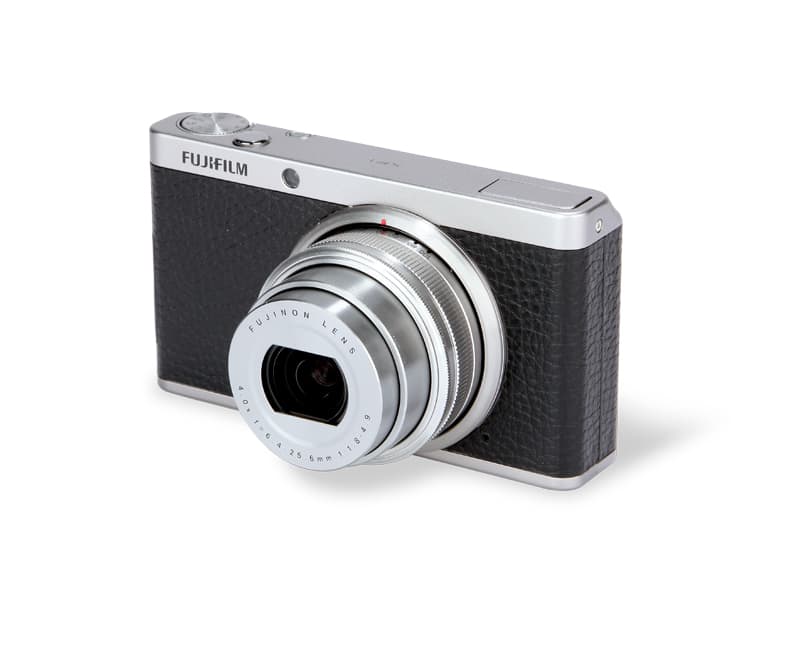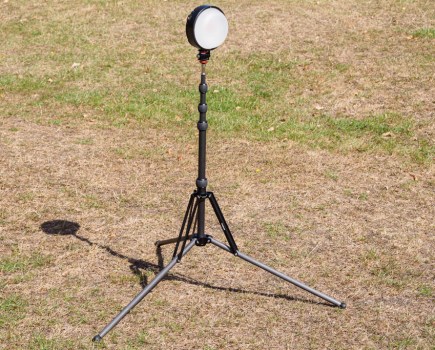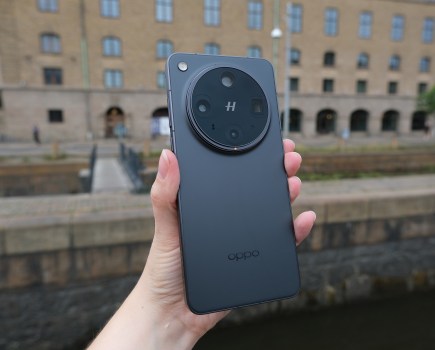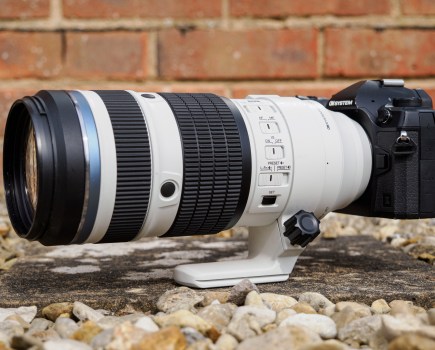Fujifilm XF1 at a glance:
- 2/3in (8.8×6.6mm) CMOS sensor with 12 million effective pixels
- 6.4-25.6mm (25-100mm equivalent) Fujinon lens
- f/1.8-4.9 maximum aperture
- ISO 100-3200 (extended to 12,800)
- 107.9×61.5x33mm
- 255g incl battery and card
- Street price around £350
Fujifilm XF1 review – Introduction
Fujifilm has added a truly compact-sized model to its fashionable X-series in the form of the XF1. The camera sits in the high-end compact camera market, offering raw and JPEG capture and manual-exposure controls. Crowded though this market now is, the XF1’s slim design and simple layout puts it head-to-head with the Sony Cyber-shot DSC-RX100 and Canon PowerShot S110, the most direct competition. Other high-end models are less ‘pocketable’ and usually feature bodies more crowded with controls.
Where the Fujifilm XF1 stands out from the crowd is in its attractive exterior, with leather-like finish and aluminium top-plate, much like the original X-series camera, the FinePix X100. Like the X10 (and X-S1 bridge camera), the XF1 uses the ‘larger-than-normal’, 12-million-pixel imaging sensor, so we can expect similar image quality, too.
Features

Image: There are eight colour modes to choose from, including Standard, Vivid and Black & white
Despite being one of the smallest high-end compact cameras, the XF1 uses a 2/3in (8.8 x 6.6mm) EXR CMOS sensor, which is approximately 25% bigger than the 1/1.7in sensors in most other high-end compacts. This gives a 3.93x focal magnification, which means the 6.4-25.6mm Fujinon zoom lens gives the same angle of view as a 25-100mm lens on a full-frame model. It comes equipped with image stabilisation for single or continuous capture, and has a handy design, which I will explain in the build and handling section.
Raw + JPEG capture up to a 12-million-pixel resolution is fairly standard for this type of compact camera. However, the XF1 uses a bigger sensor than most others, so the photosites (pixels) are physically larger, too, which should impact upon the sensor’s ability to collect light. In fact, the sensor is Fuji’s unique EXR-type and, in its High ISO & Low Noise and D-Range Priority options, it offers two modes that benefit the camera’s performance in low-level and high-contrast light respectively. In the EXR design, red, green and blue pixels are grouped in pairs rather than the Bayer ‘quad’ arrangement used in most other cameras. Each EXR mode then combines the pairs, in a process designed either to reduce noise or extend the dynamic range, and results in a 6-million-pixel image. For more on the EXR sensor, see our review of the Fujifilm X10 in AP 10 December 2011.
As well as PASM shooting modes, there are two custom settings, the company’s EXR auto mode, 16 scene modes and an Advanced Filter menu with options for motion panorama (120°, 180° and 360°), 3D and a two-image multiple exposure, among others. Drive modes include a ‘best-frame’ capture over 16 frames, and continuous high-speed shooting up to 10fps at medium quality, or 7fps at full resolution.
Build and handling

All Fujifilm X models are stylish, but the XF1 is especially so. It is available in a black, tan or red leather-like finish that, with the silver-top-plate, gives a retro feel.
Just like the X10, the lens of the XF1 is controlled manually and doubles up to turn on the camera. This makes for a rapid start-up time that Fuji claims to be 0.55sec, which I can attest to.
An excellent feature of the lens is that it retracts into the body, so the camera packs away to a compact size and can be comfortably slipped into a trouser pocket when not in use. Unfortunately, to go from the fully off position to adjust the focal length is a fiddly four-part process (and there is not a lot of lens to work with). The user must make a small turn, pull out the lens barrel, turn it again to standby and then turn it once more to adjust the focal length. With practice, however, it is effective, and precise adjustments are possible. Key focal lengths within the 25-100mm range are marked out on the barrel as a handy aid.
Perhaps on account of its collapsible and compact design, the maximum aperture of the lens is reduced to a greater degree than in the X10. The f/1.8 aperture at the wide 25mm end is faster, but at the telephoto end it reduces to f/4.9, compared to the X10’s f/2-2.8 maximum aperture. In fact, the fastest aperture reduces quickly down the range, with f/4.9 the fastest setting even at 70mm. With no built-in ND filter, the fastest shutter speed of 1/2000sec renders the wide f/1.8 aperture setting unusable in bright light.
In keeping with the XF1’s slim and elegant design, the button layout is minimal, although two function buttons provide a high level of customisation and quick access to key controls. A function button on the top-plate can be assigned to one control, such as ISO, while the E-Fn button on the rear opens the function menu where up to six controls can be assigned to the buttons on the camera’s rear. In effect, this doubles the number of controls available on the rear. In general use, then, there will be little need to enter the main menu to access key exposure controls if the user assigns the buttons wisely.
A built-in flash is included, although it has only a modest output that is manually adjustable by up to ±2/3EV. The camera lacks a hotshoe for attaching other accessories, such as a viewfinder or external flash unit. The battery life of the X10 is disappointingly brief at around 270 shots, and although the XF1 uses the same battery it is CIPA rated to 300 shots, which is still rather modest.
White balance and colour

Image: Skin tones are accurate in this portrait taken in overcast conditions and recorded in JPEG format, using AWB
Despite packing a sensor that uses Fuji’s EXR colour array rather than a Bayer arrangement, it is difficult to notice drastic differences in real-world images between the XF1’s colour rendition and that of other similar cameras. Like all Fuji’s current digital cameras, the colour mode menu is called Film Simulation, and includes three colour modes named after the company’s own film. Provia is the standard mode and gives relatively natural results, while Velvia creates a pleasant, vivid rendition that refrains from oversaturation.
There is also a black & white mode with a choice of yellow, red or green filter effects. These key filters are designed to cover most general shooting, with the green filter flattering for portraits and red filter for adding tonal depth to the sky in a landscape.
As with most auto white balance systems, a dominant colour in the scene can trick the camera into producing an ‘off’ colour cast, so shooting in raw is advisable for general use so that changes can be made post-capture. When time permits, taking a custom reading is quick, as is changing to a suitable white balance preset. As a default, white balance is accessed by one of the buttons on the rear through the E-Fn menu.
Metering
‘Photometry’ is the name of Fuji’s metering system, which offers spot, centre or evaluative metering, the latter being made up of 256 segments. We have used this system before, and as I expected, the XF1’s multi-segment metering is geared towards print-ready exposures. This can mean that highlight areas are overexposed and top highlight detail is lost. Dialling in -0.7EV when shooting in auto or semi-manual exposure modes can be worthwhile in order to preserve some of these details.
For precise metering on a given subject, the handling of spot metering is intuitive and it can be accessed directly via the E-Fn menu and one of the rear buttons. The spot is linked to the AF mode, and can be positioned over most parts of the frame. The spot can then be set to one of five sizes, the largest being a thankfully modest size, while the smallest is very precise.

Image: A dark exposure was needed here for the dramatic sky. Brightening the exposure +2EV shows detail is present in shadow areas, but so too is luminance noise
Autofocus
Fuji claims that the XF1 has an AF speed of 0.16secs, which I have no reason to doubt when shooting static subjects under good-contrast light. The camera is both snappy and sharp. As one would expect, in low-contrast light the AF speed is a little slower, and in really low light the camera needs to make use of its AF assist lamp for close-range subjects to achieve an accurate focus. Tracking AF is reasonably successful, although it does lag behind faster-moving subjects. As noted in Metering, spot AF for any one of 49 points is quick to select and has good coverage of the frame.
Manual focus is adjusted via the control wheel (which can be switched from clockwise to anti-clockwise operation). In this focus mode, manual focus assist is very helpful, although the camera lacks a distance scale to indicate what range the focus is selected to. There is a minimum focus distance of 3cm (at the widest lens setting), whereas other cameras at this level usually offer a 1cm macro mode so you can get in even closer to the subject.
LCD, viewfinder and video
Unlike its larger X10 counterpart, the XF1 has neither built-in viewfinder nor hotshoe to allow an external viewfinder to be attached, so it relies on the 3in LCD screen. It has a ‘tempered’ and scratch-free surface and a 460,000-dot resolution, which is a little low when compared to the competition, but is a bright display nonetheless. A monitor ‘sunlight’ mode boosts the output of the display to make it easier to view in bright light, which makes a subtle difference.
Full HD 1080p video recording at 30fps is standard in a camera at this level, as is stereo sound. In movie mode, focusing is selectable to centre frame or continuous.
Noise, resolution and sensitivity

Our resolution chart indicates centre sharpness, for which the XF1 gives a solid performance when used in its optimum setting. When used at the 50mm focal-length setting, the camera is able to resolve up to the 24 marker at ISO 100, which is competitive for a camera at this level but not particularly outstanding.
Results demonstrate, however, that the XF1 is a very capable performer up the ISO range, being able to resolve up to the 20 marker at ISO 3200. This shows a good low-light capability, and is slightly better than that of a number of competitors. The extended ISO 6400 and 12,800 settings use a reduced file size and significantly reduce any discernible detail.
Being made up of seven elements in six groups, the lens design is less complex than that in the X10, possibly because of its size. Overall sharpness isn’t quite to the same level. At the wider focal lengths, detail in the corner of the frame is compromised somewhat, where it is stretched and softened by barrel distortion.
These images show 72ppi (100% on a computer screen) sections of images of a resolution chart, captured with the lens set to 50mm and f/5.6. We show the section of the resolution chart where the camera starts to fail to reproduce the lines separately. The higher the number visible in these images, the better the camera’s detail resolution at the specified sensitivity setting.
Dynamic range
In the standard shooting mode, the XF1’s dynamic range is relatively pedestrian. It is in using the dynamic range modes that the camera begins to excel. First, these modes boost the dynamic range by 100%, 200% or 400%, depending on the selected ISO setting. For example, 400% is not available at ISO 100 or 200. For scenes of high contrast, it is certainly worth using the 200% setting, because some of the highlight detail is brought back and the end results remain realistic.
For lovers of punchy images, however, the 400% can go a little too far, producing that HDR-type effect where shadows are brightened, highlights are darkened and the overall exposure is a little flat. To achieve the dynamic range boost automatically, the D-Range Priority mode in the EXR menu behaves in a similar manner to the manual dynamic range modes, although it only produces 6-million-pixel images.
Our verdict
The fujifilm XF1 is an attractive high-end compact camera with easy handling thanks to a simple layout and clever E-Fn button. With a larger-than-normal sensor, the XF1 has a solid low-light performance, too. Well done to Fuji for trying something different with the lens design, which could have been the camera’s trump card but for its fiddly handling, average maximum aperture at mid to telephoto settings and, disappointingly, soft edge detail. All in all, the XF1 looks the part, handles well and offers plenty of shooting modes, but its final image quality is bettered by some of the competition.







